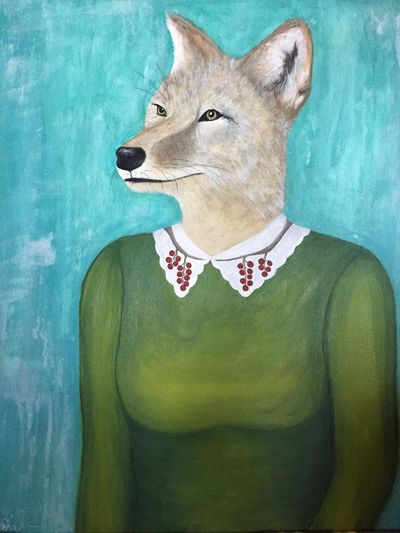Interpreting grief: Cahoon’s poems, images draw on tribal background

Montana artist Heather Cahoon has never shown her paintings while reading her poetry at the same time before. But Saturday, the Confederated Salish and Kootenai Tribes member will gather her manuscript-in-progress and a dozen paintings depicting characters and text from those poems for Scablands Lit’s “Horsefly Dress: a Poetry Reading and Art Show with Heather Cahoon.”
The event, from 4 to 5:30 p.m. at the Richmond Art Collective downtown, is a rare opportunity to experience art and poetry at an intimate venue, said Ellen Welcker, co-facilitator of Scablands Lit, which strives to support Inland Northwest writers.
“To hear from a multidisciplined artist who is open to creating in the vein that is most urgent is a pretty beautiful thing,” Welcker said.
Immediately after the performance at the Richmond, Cahoon will load her canvases back into her car for the return trip home to Montana. “It’s like a pop-up art show,” Welcker said.
Cahoon works as the state-tribal policy analyst for the Montana Budget and Policy Center. She grew up on the Flathead Indian Reservation in Western Montana and has been a longtime advocate for sustainable reservation economies and social and civil justice for tribal members. She earned a Master of Fine Arts in poetry at the University of Montana, followed by a doctorate in history, anthropology and Native American studies. She was the recipient of a 2015 Montana Arts Council Artist Innovation Award, the 2000 Richard Hugo Memorial Scholarship and the 2005 Merriam-Frontier Award for publication of her chapbook “Elk Thirst.”
The poems Cahoon will read in Spokane are meant to document and share some of the ways we have learned to deal with grief. “With how we make sense of it, how it impacts us in conscious and subconscious ways, and how ultimately we process it (or don’t),” Cahoon said.
Cahoon’s poems are very much grounded in the physical and cultural landscape of her reservation. They are largely narrative, relating stories from her own personal and family experiences, as well as from her tribal community in the form of oral traditions. “I love stories, and they have always provided a framework for my writing – and for my painting, too, now that I’ve started painting,” Cahoon said.
Cahoon’s foray into painting has produced powerful images from the folk art tradition. The paintings, like her writing, emphasize the cultural identity and shared community of her tribal background.
“Some of the paintings have lines of poetry scrawled on them and others just reflect selected images from various poems,” Cahoon said.
In an excerpt from the poem “Horsefly Dress,” Cahoon writes:
In an outpouring of story
twelve thousand years old I hear her name: Catniqs.
The hunting moon unearths Coyote’s eldest and only daughter,
her name no longer spoken, she had turned
to porous stone. But I hear her name Catniqs along the river
near Revais
in the cutting of meat and its crackled
drying in the smoldering of cottonwood.
The accompanying image Cahoon created is an oil painting of Coyote’s daughter, whose body is wholly human and womanly, clad in a green dress with a rather sweet, embellished collar. Her head and neck, on the other hand, are pure coyote.
Much of what Cahoon reads works its way into her writing (right now she’s just finishing up Joseph Campbell’s “The Power of Myth” and Arthur Sze’s “The Redshifting Web”). She also draws from reports and articles she comes across in her work as the state-tribal policy analyst.
“As for painting, I just paint whatever comes out,” Cahoon said. “The painting titled ‘Horsefly Dress’ came about because she had been in my mind for weeks, and I had been writing about her and I knew I wanted to paint her.”
In this show, the literary and the visual arts have equal weight. For noncreatives, the idea that a single person could both write poetry and create art works is incredible.
“I think the poet and jeweler Paige Taggart explained it best in an interview in Literary Hub entitled ‘Why Are So Many Poets Also Artists?’ ” Welcker said. “It’s the notion that many multidisciplined artists are ‘tied to abundant vaults of interpretation.’ ”